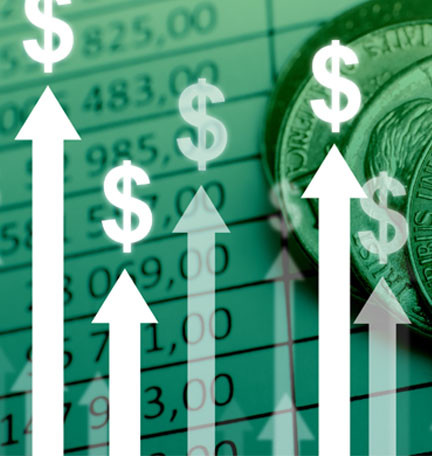If market volatility keeps you up at night, you may need to change your attitude—or your investments.
Does a sharp drop in the stock market make you want to sprint for the exits? You’re not alone. One of the illogical open secrets of the supposedly rational financial markets is that all it takes for a “risk tolerant” investor to become risk averse is a 10% or 20% drop in the Dow Jones Industrial Average.
“Most people say that they can handle a 10% drop in the market, but when their $10 million portfolio drops to $9 million, they react completely differently,” says Alan McKnight, Chief Investment Officer at Regions Wealth Management.
McKnight blames himself—well, at least as a part of the community of investment professionals who fail to realize that when professional investment advisors talk about risk, their clients often misunderstand what they mean.
When investors speak about investment risks, they’re worried about the chance of loss, he explains. When advisors speak about risk, they’re talking about volatility—how much an investment’s performance is likely to deviate in price. “We have not done a good job of linking the two,” he says.
In a market that hangs its hat on the close correlation between risk and reward, that’s an important distinction. And it helps explain why advisors actually think that putting all of your money in supposedly “safe” investments may be the riskiest course of all.
Risk Versus Reward
To clarify, let’s take a look at a handful of investment categories—big company stocks; long-term government bonds; and U.S. Treasury bills—and how they’ve performed over time.
- U.S. stocks are considered the riskiest of these assets because stock prices fluctuate widely over short periods. Indeed, in the worst year for U.S. stocks, prices dropped a whopping 43.34%. In their best year, stocks returned nearly 54%. Over the long haul, the overall return of big company U.S. stocks has averaged 10%—some 7 percentage points more than the long-term rate of inflation.
- U.S. Treasury bills, on the other hand, are the least risky asset. While they don’t appreciate much on an annual basis, they also rarely depreciate. In the worst year, total returns on Treasury bills fell a minuscule 0.02%. The average annual return on Treasury bills is about 3.4%—just a hair over the long-term rate of inflation.
- Long-term government bonds make up the middle ground, losing less than 15% in their worst year, and returning about 5.5% on average over the long haul.
In Dollars
What do those numbers mean to a long-term investor? Let’s say you invest $500 a month over the course of 30 years. If your investments were in big company U.S. stocks, your portfolio would suffer a lot of ups and downs along the way.
In fact, you should expect the S&P 500 (the most popular index measuring U.S. stock returns) to drop by 5% three times every year, by 10% once a year and by 20% every three years, says McKnight. But the upswings are typically equally dramatic. And if you can stomach the ride, the rewards can be substantial.
Assuming that you realized that 10% average annual return, you’d have accumulated $1.13 million at the end of the 30-year period. (Interesting side note: a mere $180,000 of that more-than-a-million-dollar pot of money came from his contributions; the rest was built up through compound investment returns.)
If you’d chosen to invest in Treasury bills instead, your portfolio would have suffered nearly no swings in value at all. But it would be worth just $312,211 at the end of the 30-year period—some 72% less than if he’d taken the “riskier” course.
Bigger Risks
Importantly, too, inflation eats into buying power over time at an average rate of 2.9%, which means the person who took the safe course was just treading water, economically speaking; while the person who took some risk actually boosted his buying power over time.
“If you have so much capital that you can live on your savings without any return at all, you don’t need to take any investment risk,” says McKnight. “But very few people fall into that category.”
The chance of running out of money before you run out of breath may be far more significant than the risk of having to ride through a temporary market downturn, he adds. While market downturns are regular, they are also typically short-lived. The average bear market (one where stock prices drop 20% or more) lasts just 13 months.
But what if you’re retiring in a few years? Or you don’t have the temperament to suffer through a dramatic market swing? That’s what diversification is for.
Instead of investing every dollar in one asset class like the hypothetical investor above, the wise person has some money in stocks—both domestic and international—some in bonds and some in cash. The cash stockpile is there to make you secure in the notion that you can handle emergencies, as well as for day-to-day needs in retirement, like groceries; the bonds are there for stability and diversification; while the stocks may provide the long-term growth that helps you maintain your buying power even into your dotage, long after you’ve left the working world.
The right amount of each investment will vary from person to person, based on their assets, circumstances and ability to tolerate market swings. What’s imperative is that you have a thought-out plan that you can live with through thick and thin. If you don’t, the biggest risk to your wealth may be you.
“It’s easy to say that you can tolerate a 20% loss, but if you have an emotional reaction and sell out in a panic, you can turn a temporary market loss into a permanent loss of capital,” says McKnight. “It’s very important to be able to stick with the plan.
Talk to Your Advisor About:
- Whether or not your current portfolio is aligned with your risk tolerance
- Strategies that might help moderate the effect of inflation and market volatility on your investments
- What options you might have for a “Plan B” if market volatility affects your near-term goals











